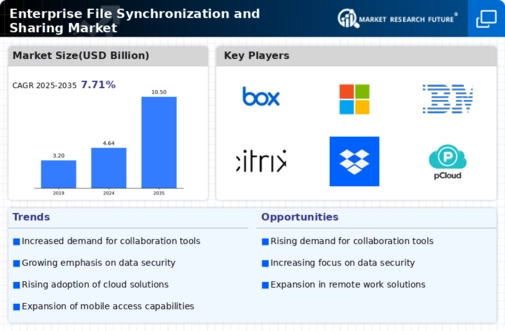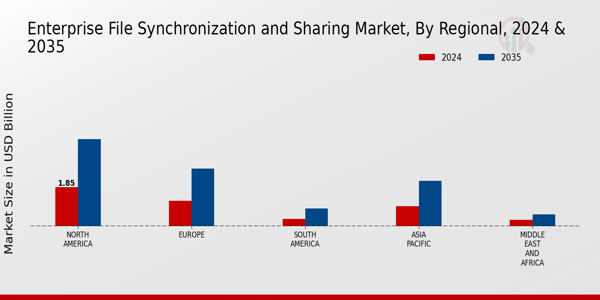-
Medium Enterprises\r\nLarge Enterprises\r\nGovernment Agencies\r\nEducational Institutions\r\n\r\n\r\nEnterprise File Synchronization and Sharing Market, BY Service Type (USD
-
Billion)\r\n\r\nManaged Services\r\nProfessional Services\r\nSupport and Maintenance\r\n\r\n\r\nEnterprise File Synchronization and Sharing Market, BY Regional (USD
-
Billion)\r\n\r\nNorth America\r\n\r\nUS\r\nCanada\r\n\r\n\r\nEurope\r\n\r\nGermany\r\nUK\r\nFrance\r\nRussia\r\nItaly\r\nSpain\r\nRest
-
of Europe\r\n\r\n\r\nAPAC\r\n\r\nChina\r\nIndia\r\nJapan\r\nSouth
-
Korea\r\nMalaysia\r\nThailand\r\nIndonesia\r\nRest
-
of APAC\r\n\r\n\r\nSouth America\r\n\r\nBrazil\r\nMexico\r\nArgentina\r\nRest
-
of South America\r\n\r\n\r\nMEA\r\n\r\nGCC
-
Countries\r\nSouth Africa\r\nRest of MEA\r\n\r\n\r\n\r\n\r\n\r\n
-
\r\n
-
\r\n\r\nCompetitive Landscape\r\n\r\nOverview\r\nCompetitive
-
Analysis\r\nMarket share Analysis\r\nMajor Growth Strategy in the Enterprise File Synchronization
-
and Sharing Market\r\nCompetitive Benchmarking\r\nLeading Players in Terms of Number of Developments
-
in the Enterprise File Synchronization and Sharing Market\r\nKey developments and growth strategies\r\n\r\nNew Product Launch/Service
-
Deployment\r\nMerger & Acquisitions\r\nJoint Ventures\r\n\r\n\r\nMajor Players Financial Matrix\r\n\r\nSales
-
and Operating Income\r\nMajor Players R&D Expenditure. 2023\r\n\r\n\r\n\r\n\r\n\r\n\r\nCompany Profiles\r\n\r\nIBM\r\n\r\nFinancial Overview\r\nProducts
-
Offered\r\nKey Developments\r\nSWOT Analysis\r\nKey Strategies\r\n\r\n\r\nBitTorrent\r\n\r\nFinancial Overview\r\nProducts
-
Offered\r\nKey Developments\r\nSWOT Analysis\r\nKey Strategies\r\n\r\n\r\nEgnyte\r\n\r\nFinancial Overview\r\nProducts
-
Offered\r\nKey Developments\r\nSWOT Analysis\r\nKey Strategies\r\n\r\n\r\nDropbox\r\n\r\nFinancial Overview\r\nProducts
-
Offered\r\nKey Developments\r\nSWOT Analysis\r\nKey Strategies\r\n\r\n\r\npCloud\r\n\r\nFinancial Overview\r\nProducts
-
Offered\r\nKey Developments\r\nSWOT Analysis\r\nKey Strategies\r\n\r\n\r\nGoogle\r\n\r\nFinancial Overview\r\nProducts
-
Offered\r\nKey Developments\r\nSWOT Analysis\r\nKey Strategies\r\n\r\n\r\nResilio\r\n\r\nFinancial Overview\r\nProducts
-
Offered\r\nKey Developments\r\nSWOT Analysis\r\nKey Strategies\r\n\r\n\r\nMicrosoft\r\n\r\nFinancial Overview\r\nProducts
-
Offered\r\nKey Developments\r\nSWOT Analysis\r\nKey Strategies\r\n\r\n\r\nSugarSync\r\n\r\nFinancial Overview\r\nProducts
-
Offered\r\nKey Developments\r\nSWOT Analysis\r\nKey Strategies\r\n\r\n\r\nSyncplicity\r\n\r\nFinancial Overview\r\nProducts
-
Offered\r\nKey Developments\r\nSWOT Analysis\r\nKey Strategies\r\n\r\n\r\nVMware\r\n\r\nFinancial Overview\r\nProducts
-
Offered\r\nKey Developments\r\nSWOT Analysis\r\nKey Strategies\r\n\r\n\r\nBox\r\n\r\nFinancial Overview\r\nProducts
-
Offered\r\nKey Developments\r\nSWOT Analysis\r\nKey Strategies\r\n\r\n\r\nCitrix\r\n\r\nFinancial Overview\r\nProducts
-
Offered\r\nKey Developments\r\nSWOT Analysis\r\nKey Strategies\r\n\r\n\r\nNextcloud\r\n\r\nFinancial Overview\r\nProducts
-
Offered\r\nKey Developments\r\nSWOT Analysis\r\nKey Strategies\r\n\r\n\r\nNetDocuments\r\n\r\nFinancial Overview\r\nProducts
-
Offered\r\nKey Developments\r\nSWOT Analysis\r\nKey Strategies\r\n\r\n\r\n\r\n\r\n\r\n\r\nAppendix\r\n\r\nReferences\r\nRelated Reports\r\n\r\n\r\n\r\nLIST
-
Of tables
-
\r\n
-
\r\n\r\nLIST OF ASSUMPTIONS\r\nNorth
-
America Enterprise File Synchronization and Sharing Market SIZE ESTIMATES &
-
FORECAST, BY DEPLOYMENT MODEL, 2019-2035 (USD Billions)\r\nNorth America
-
Enterprise File Synchronization and Sharing Market SIZE ESTIMATES & FORECAST,
-
BY APPLICATION, 2019-2035 (USD Billions)\r\nNorth America Enterprise File
-
Synchronization and Sharing Market SIZE ESTIMATES & FORECAST, BY END USER, 2019-2035
-
(USD Billions)\r\nNorth America Enterprise File Synchronization and Sharing
-
Market SIZE ESTIMATES & FORECAST, BY SERVICE TYPE, 2019-2035 (USD Billions)\r\nNorth
-
America Enterprise File Synchronization and Sharing Market SIZE ESTIMATES &
-
FORECAST, BY REGIONAL, 2019-2035 (USD Billions)\r\nUS Enterprise File Synchronization
-
and Sharing Market SIZE ESTIMATES & FORECAST, BY DEPLOYMENT MODEL, 2019-2035
-
(USD Billions)\r\nUS Enterprise File Synchronization and Sharing Market
-
SIZE ESTIMATES & FORECAST, BY APPLICATION, 2019-2035 (USD Billions)\r\nUS
-
Enterprise File Synchronization and Sharing Market SIZE ESTIMATES & FORECAST,
-
BY END USER, 2019-2035 (USD Billions)\r\nUS Enterprise File Synchronization
-
and Sharing Market SIZE ESTIMATES & FORECAST, BY SERVICE TYPE, 2019-2035 (USD
-
Billions)\r\nUS Enterprise File Synchronization and Sharing Market SIZE
-
ESTIMATES & FORECAST, BY REGIONAL, 2019-2035 (USD Billions)\r\nCanada
-
Enterprise File Synchronization and Sharing Market SIZE ESTIMATES & FORECAST,
-
BY DEPLOYMENT MODEL, 2019-2035 (USD Billions)\r\nCanada Enterprise File
-
Synchronization and Sharing Market SIZE ESTIMATES & FORECAST, BY APPLICATION,
-
Sharing Market SIZE ESTIMATES & FORECAST, BY END USER, 2019-2035 (USD Billions)\r\nCanada
-
Enterprise File Synchronization and Sharing Market SIZE ESTIMATES & FORECAST,
-
BY SERVICE TYPE, 2019-2035 (USD Billions)\r\nCanada Enterprise File Synchronization
-
and Sharing Market SIZE ESTIMATES & FORECAST, BY REGIONAL, 2019-2035 (USD Billions)\r\nEurope
-
Enterprise File Synchronization and Sharing Market SIZE ESTIMATES & FORECAST,
-
BY DEPLOYMENT MODEL, 2019-2035 (USD Billions)\r\nEurope Enterprise File
-
Synchronization and Sharing Market SIZE ESTIMATES & FORECAST, BY APPLICATION,
-
Sharing Market SIZE ESTIMATES & FORECAST, BY END USER, 2019-2035 (USD Billions)\r\nEurope
-
Enterprise File Synchronization and Sharing Market SIZE ESTIMATES & FORECAST,
-
BY SERVICE TYPE, 2019-2035 (USD Billions)\r\nEurope Enterprise File Synchronization
-
and Sharing Market SIZE ESTIMATES & FORECAST, BY REGIONAL, 2019-2035 (USD Billions)\r\nGermany
-
Enterprise File Synchronization and Sharing Market SIZE ESTIMATES & FORECAST,
-
BY DEPLOYMENT MODEL, 2019-2035 (USD Billions)\r\nGermany Enterprise File
-
Synchronization and Sharing Market SIZE ESTIMATES & FORECAST, BY APPLICATION,
-
Sharing Market SIZE ESTIMATES & FORECAST, BY END USER, 2019-2035 (USD Billions)\r\nGermany
-
Enterprise File Synchronization and Sharing Market SIZE ESTIMATES & FORECAST,
-
BY SERVICE TYPE, 2019-2035 (USD Billions)\r\nGermany Enterprise File Synchronization
-
and Sharing Market SIZE ESTIMATES & FORECAST, BY REGIONAL, 2019-2035 (USD Billions)\r\nUK
-
Enterprise File Synchronization and Sharing Market SIZE ESTIMATES & FORECAST,
-
BY DEPLOYMENT MODEL, 2019-2035 (USD Billions)\r\nUK Enterprise File Synchronization
-
and Sharing Market SIZE ESTIMATES & FORECAST, BY APPLICATION, 2019-2035 (USD
-
Billions)\r\nUK Enterprise File Synchronization and Sharing Market SIZE
-
ESTIMATES & FORECAST, BY END USER, 2019-2035 (USD Billions)\r\nUK Enterprise
-
File Synchronization and Sharing Market SIZE ESTIMATES & FORECAST, BY SERVICE
-
TYPE, 2019-2035 (USD Billions)\r\nUK Enterprise File Synchronization and
-
Sharing Market SIZE ESTIMATES & FORECAST, BY REGIONAL, 2019-2035 (USD Billions)\r\nFrance
-
Enterprise File Synchronization and Sharing Market SIZE ESTIMATES & FORECAST,
-
BY DEPLOYMENT MODEL, 2019-2035 (USD Billions)\r\nFrance Enterprise File
-
Synchronization and Sharing Market SIZE ESTIMATES & FORECAST, BY APPLICATION,
-
Sharing Market SIZE ESTIMATES & FORECAST, BY END USER, 2019-2035 (USD Billions)\r\nFrance
-
Enterprise File Synchronization and Sharing Market SIZE ESTIMATES & FORECAST,
-
BY SERVICE TYPE, 2019-2035 (USD Billions)\r\nFrance Enterprise File Synchronization
-
and Sharing Market SIZE ESTIMATES & FORECAST, BY REGIONAL, 2019-2035 (USD Billions)\r\nRussia
-
Enterprise File Synchronization and Sharing Market SIZE ESTIMATES & FORECAST,
-
BY DEPLOYMENT MODEL, 2019-2035 (USD Billions)\r\nRussia Enterprise File
-
Synchronization and Sharing Market SIZE ESTIMATES & FORECAST, BY APPLICATION,
-
Sharing Market SIZE ESTIMATES & FORECAST, BY END USER, 2019-2035 (USD Billions)\r\nRussia
-
Enterprise File Synchronization and Sharing Market SIZE ESTIMATES & FORECAST,
-
BY SERVICE TYPE, 2019-2035 (USD Billions)\r\nRussia Enterprise File Synchronization
-
and Sharing Market SIZE ESTIMATES & FORECAST, BY REGIONAL, 2019-2035 (USD Billions)\r\nItaly
-
Enterprise File Synchronization and Sharing Market SIZE ESTIMATES & FORECAST,
-
BY DEPLOYMENT MODEL, 2019-2035 (USD Billions)\r\nItaly Enterprise File
-
Synchronization and Sharing Market SIZE ESTIMATES & FORECAST, BY APPLICATION,
-
Market SIZE ESTIMATES & FORECAST, BY END USER, 2019-2035 (USD Billions)\r\nItaly
-
Enterprise File Synchronization and Sharing Market SIZE ESTIMATES & FORECAST,
-
BY SERVICE TYPE, 2019-2035 (USD Billions)\r\nItaly Enterprise File Synchronization
-
and Sharing Market SIZE ESTIMATES & FORECAST, BY REGIONAL, 2019-2035 (USD Billions)\r\nSpain
-
Enterprise File Synchronization and Sharing Market SIZE ESTIMATES & FORECAST,
-
BY DEPLOYMENT MODEL, 2019-2035 (USD Billions)\r\nSpain Enterprise File
-
Synchronization and Sharing Market SIZE ESTIMATES & FORECAST, BY APPLICATION,
-
Market SIZE ESTIMATES & FORECAST, BY END USER, 2019-2035 (USD Billions)\r\nSpain
-
Enterprise File Synchronization and Sharing Market SIZE ESTIMATES & FORECAST,
-
BY SERVICE TYPE, 2019-2035 (USD Billions)\r\nSpain Enterprise File Synchronization
-
and Sharing Market SIZE ESTIMATES & FORECAST, BY REGIONAL, 2019-2035 (USD Billions)\r\nRest
-
of Europe Enterprise File Synchronization and Sharing Market SIZE ESTIMATES &
-
FORECAST, BY DEPLOYMENT MODEL, 2019-2035 (USD Billions)\r\nRest of Europe
-
Enterprise File Synchronization and Sharing Market SIZE ESTIMATES & FORECAST,
-
BY APPLICATION, 2019-2035 (USD Billions)\r\nRest of Europe Enterprise File
-
Synchronization and Sharing Market SIZE ESTIMATES & FORECAST, BY END USER, 2019-2035
-
(USD Billions)\r\nRest of Europe Enterprise File Synchronization and Sharing
-
Market SIZE ESTIMATES & FORECAST, BY SERVICE TYPE, 2019-2035 (USD Billions)\r\nRest
-
of Europe Enterprise File Synchronization and Sharing Market SIZE ESTIMATES &
-
FORECAST, BY REGIONAL, 2019-2035 (USD Billions)\r\nAPAC Enterprise File
-
Synchronization and Sharing Market SIZE ESTIMATES & FORECAST, BY DEPLOYMENT
-
MODEL, 2019-2035 (USD Billions)\r\nAPAC Enterprise File Synchronization
-
and Sharing Market SIZE ESTIMATES & FORECAST, BY APPLICATION, 2019-2035 (USD
-
Billions)\r\nAPAC Enterprise File Synchronization and Sharing Market SIZE
-
ESTIMATES & FORECAST, BY END USER, 2019-2035 (USD Billions)\r\nAPAC
-
Enterprise File Synchronization and Sharing Market SIZE ESTIMATES & FORECAST,
-
BY SERVICE TYPE, 2019-2035 (USD Billions)\r\nAPAC Enterprise File Synchronization
-
and Sharing Market SIZE ESTIMATES & FORECAST, BY REGIONAL, 2019-2035 (USD Billions)\r\nChina
-
Enterprise File Synchronization and Sharing Market SIZE ESTIMATES & FORECAST,
-
BY DEPLOYMENT MODEL, 2019-2035 (USD Billions)\r\nChina Enterprise File
-
Synchronization and Sharing Market SIZE ESTIMATES & FORECAST, BY APPLICATION,
-
Market SIZE ESTIMATES & FORECAST, BY END USER, 2019-2035 (USD Billions)\r\nChina
-
Enterprise File Synchronization and Sharing Market SIZE ESTIMATES & FORECAST,
-
BY SERVICE TYPE, 2019-2035 (USD Billions)\r\nChina Enterprise File Synchronization
-
and Sharing Market SIZE ESTIMATES & FORECAST, BY REGIONAL, 2019-2035 (USD Billions)\r\nIndia
-
Enterprise File Synchronization and Sharing Market SIZE ESTIMATES & FORECAST,
-
BY DEPLOYMENT MODEL, 2019-2035 (USD Billions)\r\nIndia Enterprise File
-
Synchronization and Sharing Market SIZE ESTIMATES & FORECAST, BY APPLICATION,
-
Market SIZE ESTIMATES & FORECAST, BY END USER, 2019-2035 (USD Billions)\r\nIndia
-
Enterprise File Synchronization and Sharing Market SIZE ESTIMATES & FORECAST,
-
BY SERVICE TYPE, 2019-2035 (USD Billions)\r\nIndia Enterprise File Synchronization
-
and Sharing Market SIZE ESTIMATES & FORECAST, BY REGIONAL, 2019-2035 (USD Billions)\r\nJapan
-
Enterprise File Synchronization and Sharing Market SIZE ESTIMATES & FORECAST,
-
BY DEPLOYMENT MODEL, 2019-2035 (USD Billions)\r\nJapan Enterprise File
-
Synchronization and Sharing Market SIZE ESTIMATES & FORECAST, BY APPLICATION,
-
Market SIZE ESTIMATES & FORECAST, BY END USER, 2019-2035 (USD Billions)\r\nJapan
-
Enterprise File Synchronization and Sharing Market SIZE ESTIMATES & FORECAST,
-
BY SERVICE TYPE, 2019-2035 (USD Billions)\r\nJapan Enterprise File Synchronization
-
and Sharing Market SIZE ESTIMATES & FORECAST, BY REGIONAL, 2019-2035 (USD Billions)\r\nSouth
-
Korea Enterprise File Synchronization and Sharing Market SIZE ESTIMATES & FORECAST,
-
BY DEPLOYMENT MODEL, 2019-2035 (USD Billions)\r\nSouth Korea Enterprise
-
File Synchronization and Sharing Market SIZE ESTIMATES & FORECAST, BY APPLICATION,
-
and Sharing Market SIZE ESTIMATES & FORECAST, BY END USER, 2019-2035 (USD Billions)\r\nSouth
-
Korea Enterprise File Synchronization and Sharing Market SIZE ESTIMATES & FORECAST,
-
BY SERVICE TYPE, 2019-2035 (USD Billions)\r\nSouth Korea Enterprise File
-
Synchronization and Sharing Market SIZE ESTIMATES & FORECAST, BY REGIONAL, 2019-2035
-
(USD Billions)\r\nMalaysia Enterprise File Synchronization and Sharing
-
Market SIZE ESTIMATES & FORECAST, BY DEPLOYMENT MODEL, 2019-2035 (USD Billions)\r\nMalaysia
-
Enterprise File Synchronization and Sharing Market SIZE ESTIMATES & FORECAST,
-
BY APPLICATION, 2019-2035 (USD Billions)\r\nMalaysia Enterprise File Synchronization
-
and Sharing Market SIZE ESTIMATES & FORECAST, BY END USER, 2019-2035 (USD Billions)\r\nMalaysia
-
Enterprise File Synchronization and Sharing Market SIZE ESTIMATES & FORECAST,
-
BY SERVICE TYPE, 2019-2035 (USD Billions)\r\nMalaysia Enterprise File Synchronization
-
and Sharing Market SIZE ESTIMATES & FORECAST, BY REGIONAL, 2019-2035 (USD Billions)\r\nThailand
-
Enterprise File Synchronization and Sharing Market SIZE ESTIMATES & FORECAST,
-
BY DEPLOYMENT MODEL, 2019-2035 (USD Billions)\r\nThailand Enterprise File
-
Synchronization and Sharing Market SIZE ESTIMATES & FORECAST, BY APPLICATION,
-
Sharing Market SIZE ESTIMATES & FORECAST, BY END USER, 2019-2035 (USD Billions)\r\nThailand
-
Enterprise File Synchronization and Sharing Market SIZE ESTIMATES & FORECAST,
-
BY SERVICE TYPE, 2019-2035 (USD Billions)\r\nThailand Enterprise File Synchronization
-
and Sharing Market SIZE ESTIMATES & FORECAST, BY REGIONAL, 2019-2035 (USD Billions)\r\nIndonesia
-
Enterprise File Synchronization and Sharing Market SIZE ESTIMATES & FORECAST,
-
BY DEPLOYMENT MODEL, 2019-2035 (USD Billions)\r\nIndonesia Enterprise File
-
Synchronization and Sharing Market SIZE ESTIMATES & FORECAST, BY APPLICATION,
-
Sharing Market SIZE ESTIMATES & FORECAST, BY END USER, 2019-2035 (USD Billions)\r\nIndonesia
-
Enterprise File Synchronization and Sharing Market SIZE ESTIMATES & FORECAST,
-
BY SERVICE TYPE, 2019-2035 (USD Billions)\r\nIndonesia Enterprise File
-
Synchronization and Sharing Market SIZE ESTIMATES & FORECAST, BY REGIONAL, 2019-2035
-
(USD Billions)\r\nRest of APAC Enterprise File Synchronization and Sharing
-
Market SIZE ESTIMATES & FORECAST, BY DEPLOYMENT MODEL, 2019-2035 (USD Billions)\r\nRest
-
of APAC Enterprise File Synchronization and Sharing Market SIZE ESTIMATES &
-
FORECAST, BY APPLICATION, 2019-2035 (USD Billions)\r\nRest of APAC Enterprise
-
File Synchronization and Sharing Market SIZE ESTIMATES & FORECAST, BY END USER,
-
and Sharing Market SIZE ESTIMATES & FORECAST, BY SERVICE TYPE, 2019-2035 (USD
-
Billions)\r\nRest of APAC Enterprise File Synchronization and Sharing Market
-
SIZE ESTIMATES & FORECAST, BY REGIONAL, 2019-2035 (USD Billions)\r\nSouth
-
America Enterprise File Synchronization and Sharing Market SIZE ESTIMATES &
-
FORECAST, BY DEPLOYMENT MODEL, 2019-2035 (USD Billions)\r\nSouth America
-
Enterprise File Synchronization and Sharing Market SIZE ESTIMATES & FORECAST,
-
BY APPLICATION, 2019-2035 (USD Billions)\r\nSouth America Enterprise File
-
Synchronization and Sharing Market SIZE ESTIMATES & FORECAST, BY END USER, 2019-2035
-
(USD Billions)\r\nSouth America Enterprise File Synchronization and Sharing
-
Market SIZE ESTIMATES & FORECAST, BY SERVICE TYPE, 2019-2035 (USD Billions)\r\nSouth
-
America Enterprise File Synchronization and Sharing Market SIZE ESTIMATES &
-
FORECAST, BY REGIONAL, 2019-2035 (USD Billions)\r\nBrazil Enterprise File
-
Synchronization and Sharing Market SIZE ESTIMATES & FORECAST, BY DEPLOYMENT
-
MODEL, 2019-2035 (USD Billions)\r\nBrazil Enterprise File Synchronization
-
and Sharing Market SIZE ESTIMATES & FORECAST, BY APPLICATION, 2019-2035 (USD
-
Billions)\r\nBrazil Enterprise File Synchronization and Sharing Market
-
SIZE ESTIMATES & FORECAST, BY END USER, 2019-2035 (USD Billions)\r\nBrazil
-
Enterprise File Synchronization and Sharing Market SIZE ESTIMATES & FORECAST,
-
BY SERVICE TYPE, 2019-2035 (USD Billions)\r\nBrazil Enterprise File Synchronization
-
and Sharing Market SIZE ESTIMATES & FORECAST, BY REGIONAL, 2019-2035 (USD Billions)\r\nMexico
-
Enterprise File Synchronization and Sharing Market SIZE ESTIMATES & FORECAST,
-
BY DEPLOYMENT MODEL, 2019-2035 (USD Billions)\r\nMexico Enterprise File
-
Synchronization and Sharing Market SIZE ESTIMATES & FORECAST, BY APPLICATION,
-
Sharing Market SIZE ESTIMATES & FORECAST, BY END USER, 2019-2035 (USD Billions)\r\nMexico
-
Enterprise File Synchronization and Sharing Market SIZE ESTIMATES & FORECAST,
-
BY SERVICE TYPE, 2019-2035 (USD Billions)\r\nMexico Enterprise File Synchronization
-
and Sharing Market SIZE ESTIMATES & FORECAST, BY REGIONAL, 2019-2035 (USD Billions)\r\nArgentina
-
Enterprise File Synchronization and Sharing Market SIZE ESTIMATES & FORECAST,
-
BY DEPLOYMENT MODEL, 2019-2035 (USD Billions)\r\nArgentina Enterprise File
-
Synchronization and Sharing Market SIZE ESTIMATES & FORECAST, BY APPLICATION,
-
Sharing Market SIZE ESTIMATES & FORECAST, BY END USER, 2019-2035 (USD Billions)\r\nArgentina
-
Enterprise File Synchronization and Sharing Market SIZE ESTIMATES & FORECAST,
-
BY SERVICE TYPE, 2019-2035 (USD Billions)\r\nArgentina Enterprise File
-
Synchronization and Sharing Market SIZE ESTIMATES & FORECAST, BY REGIONAL, 2019-2035
-
(USD Billions)\r\nRest of South America Enterprise File Synchronization
-
and Sharing Market SIZE ESTIMATES & FORECAST, BY DEPLOYMENT MODEL, 2019-2035
-
(USD Billions)\r\nRest of South America Enterprise File Synchronization
-
and Sharing Market SIZE ESTIMATES & FORECAST, BY APPLICATION, 2019-2035 (USD
-
Billions)\r\nRest of South America Enterprise File Synchronization and
-
Sharing Market SIZE ESTIMATES & FORECAST, BY END USER, 2019-2035 (USD Billions)\r\nRest
-
of South America Enterprise File Synchronization and Sharing Market SIZE ESTIMATES
-
& FORECAST, BY SERVICE TYPE, 2019-2035 (USD Billions)\r\nRest of South
-
America Enterprise File Synchronization and Sharing Market SIZE ESTIMATES &
-
FORECAST, BY REGIONAL, 2019-2035 (USD Billions)\r\nMEA Enterprise File
-
Synchronization and Sharing Market SIZE ESTIMATES & FORECAST, BY DEPLOYMENT
-
MODEL, 2019-2035 (USD Billions)\r\nMEA Enterprise File Synchronization
-
and Sharing Market SIZE ESTIMATES & FORECAST, BY APPLICATION, 2019-2035 (USD
-
Billions)\r\nMEA Enterprise File Synchronization and Sharing Market SIZE
-
ESTIMATES & FORECAST, BY END USER, 2019-2035 (USD Billions)\r\nMEA
-
Enterprise File Synchronization and Sharing Market SIZE ESTIMATES & FORECAST,
-
BY SERVICE TYPE, 2019-2035 (USD Billions)\r\nMEA Enterprise File Synchronization
-
and Sharing Market SIZE ESTIMATES & FORECAST, BY REGIONAL, 2019-2035 (USD Billions)\r\nGCC
-
Countries Enterprise File Synchronization and Sharing Market SIZE ESTIMATES &
-
FORECAST, BY DEPLOYMENT MODEL, 2019-2035 (USD Billions)\r\nGCC Countries
-
Enterprise File Synchronization and Sharing Market SIZE ESTIMATES & FORECAST,
-
BY APPLICATION, 2019-2035 (USD Billions)\r\nGCC Countries Enterprise File
-
Synchronization and Sharing Market SIZE ESTIMATES & FORECAST, BY END USER, 2019-2035
-
(USD Billions)\r\nGCC Countries Enterprise File Synchronization and Sharing
-
Market SIZE ESTIMATES & FORECAST, BY SERVICE TYPE, 2019-2035 (USD Billions)\r\nGCC
-
Countries Enterprise File Synchronization and Sharing Market SIZE ESTIMATES &
-
FORECAST, BY REGIONAL, 2019-2035 (USD Billions)\r\nSouth Africa Enterprise
-
File Synchronization and Sharing Market SIZE ESTIMATES & FORECAST, BY DEPLOYMENT
-
MODEL, 2019-2035 (USD Billions)\r\nSouth Africa Enterprise File Synchronization
-
and Sharing Market SIZE ESTIMATES & FORECAST, BY APPLICATION, 2019-2035 (USD
-
Billions)\r\nSouth Africa Enterprise File Synchronization and Sharing Market
-
SIZE ESTIMATES & FORECAST, BY END USER, 2019-2035 (USD Billions)\r\nSouth
-
Africa Enterprise File Synchronization and Sharing Market SIZE ESTIMATES & FORECAST,
-
BY SERVICE TYPE, 2019-2035 (USD Billions)\r\nSouth Africa Enterprise File
-
Synchronization and Sharing Market SIZE ESTIMATES & FORECAST, BY REGIONAL, 2019-2035
-
(USD Billions)\r\nRest of MEA Enterprise File Synchronization and Sharing
-
Market SIZE ESTIMATES & FORECAST, BY DEPLOYMENT MODEL, 2019-2035 (USD Billions)\r\nRest
-
of MEA Enterprise File Synchronization and Sharing Market SIZE ESTIMATES & FORECAST,
-
BY APPLICATION, 2019-2035 (USD Billions)\r\nRest of MEA Enterprise File
-
Synchronization and Sharing Market SIZE ESTIMATES & FORECAST, BY END USER, 2019-2035
-
(USD Billions)\r\nRest of MEA Enterprise File Synchronization and Sharing
-
Market SIZE ESTIMATES & FORECAST, BY SERVICE TYPE, 2019-2035 (USD Billions)\r\nRest
-
of MEA Enterprise File Synchronization and Sharing Market SIZE ESTIMATES & FORECAST,
-
BY REGIONAL, 2019-2035 (USD Billions)\r\nPRODUCT LAUNCH/PRODUCT DEVELOPMENT/APPROVAL\r\nACQUISITION/PARTNERSHIP\r\n\r\nLIST
-
Of figures
-
\r\n
-
\r\n\r\nMARKET
-
SYNOPSIS\r\nNORTH AMERICA ENTERPRISE FILE
-
SYNCHRONIZATION AND SHARING MARKET ANALYSIS\r\nUS
-
ENTERPRISE FILE SYNCHRONIZATION AND SHARING MARKET ANALYSIS BY DEPLOYMENT MODEL\r\nUS ENTERPRISE FILE SYNCHRONIZATION AND SHARING MARKET
-
ANALYSIS BY APPLICATION\r\nUS ENTERPRISE
-
FILE SYNCHRONIZATION AND SHARING MARKET ANALYSIS BY END USER\r\nUS ENTERPRISE FILE SYNCHRONIZATION AND SHARING MARKET ANALYSIS BY SERVICE
-
TYPE\r\nUS ENTERPRISE FILE SYNCHRONIZATION
-
AND SHARING MARKET ANALYSIS BY REGIONAL\r\nCANADA
-
ENTERPRISE FILE SYNCHRONIZATION AND SHARING MARKET ANALYSIS BY DEPLOYMENT MODEL\r\nCANADA ENTERPRISE FILE SYNCHRONIZATION AND SHARING
-
MARKET ANALYSIS BY APPLICATION\r\nCANADA
-
ENTERPRISE FILE SYNCHRONIZATION AND SHARING MARKET ANALYSIS BY END USER\r\nCANADA ENTERPRISE FILE SYNCHRONIZATION AND SHARING
-
MARKET ANALYSIS BY SERVICE TYPE\r\nCANADA
-
ENTERPRISE FILE SYNCHRONIZATION AND SHARING MARKET ANALYSIS BY REGIONAL\r\nEUROPE ENTERPRISE FILE SYNCHRONIZATION AND SHARING
-
MARKET ANALYSIS\r\nGERMANY ENTERPRISE FILE
-
SYNCHRONIZATION AND SHARING MARKET ANALYSIS BY DEPLOYMENT MODEL\r\nGERMANY ENTERPRISE FILE SYNCHRONIZATION AND SHARING MARKET ANALYSIS BY
-
APPLICATION\r\nGERMANY ENTERPRISE FILE SYNCHRONIZATION
-
AND SHARING MARKET ANALYSIS BY END USER\r\nGERMANY
-
ENTERPRISE FILE SYNCHRONIZATION AND SHARING MARKET ANALYSIS BY SERVICE TYPE\r\nGERMANY ENTERPRISE FILE SYNCHRONIZATION AND SHARING
-
MARKET ANALYSIS BY REGIONAL\r\nUK ENTERPRISE
-
FILE SYNCHRONIZATION AND SHARING MARKET ANALYSIS BY DEPLOYMENT MODEL\r\nUK ENTERPRISE FILE SYNCHRONIZATION AND SHARING MARKET
-
ANALYSIS BY APPLICATION\r\nUK ENTERPRISE
-
FILE SYNCHRONIZATION AND SHARING MARKET ANALYSIS BY END USER\r\nUK ENTERPRISE FILE SYNCHRONIZATION AND SHARING MARKET ANALYSIS BY SERVICE
-
TYPE\r\nUK ENTERPRISE FILE SYNCHRONIZATION
-
AND SHARING MARKET ANALYSIS BY REGIONAL\r\nFRANCE
-
ENTERPRISE FILE SYNCHRONIZATION AND SHARING MARKET ANALYSIS BY DEPLOYMENT MODEL\r\nFRANCE ENTERPRISE FILE SYNCHRONIZATION AND SHARING
-
MARKET ANALYSIS BY APPLICATION\r\nFRANCE
-
ENTERPRISE FILE SYNCHRONIZATION AND SHARING MARKET ANALYSIS BY END USER\r\nFRANCE ENTERPRISE FILE SYNCHRONIZATION AND SHARING
-
MARKET ANALYSIS BY SERVICE TYPE\r\nFRANCE
-
ENTERPRISE FILE SYNCHRONIZATION AND SHARING MARKET ANALYSIS BY REGIONAL\r\nRUSSIA ENTERPRISE FILE SYNCHRONIZATION AND SHARING
-
MARKET ANALYSIS BY DEPLOYMENT MODEL\r\nRUSSIA
-
ENTERPRISE FILE SYNCHRONIZATION AND SHARING MARKET ANALYSIS BY APPLICATION\r\nRUSSIA ENTERPRISE FILE SYNCHRONIZATION AND SHARING
-
MARKET ANALYSIS BY END USER\r\nRUSSIA ENTERPRISE
-
FILE SYNCHRONIZATION AND SHARING MARKET ANALYSIS BY SERVICE TYPE\r\nRUSSIA ENTERPRISE FILE SYNCHRONIZATION AND SHARING MARKET ANALYSIS BY
-
REGIONAL\r\nITALY ENTERPRISE FILE SYNCHRONIZATION
-
AND SHARING MARKET ANALYSIS BY DEPLOYMENT MODEL\r\nITALY ENTERPRISE FILE SYNCHRONIZATION AND SHARING MARKET ANALYSIS BY APPLICATION\r\nITALY ENTERPRISE FILE SYNCHRONIZATION AND SHARING
-
MARKET ANALYSIS BY END USER\r\nITALY ENTERPRISE
-
FILE SYNCHRONIZATION AND SHARING MARKET ANALYSIS BY SERVICE TYPE\r\nITALY ENTERPRISE FILE SYNCHRONIZATION AND SHARING MARKET ANALYSIS BY REGIONAL\r\nSPAIN ENTERPRISE FILE SYNCHRONIZATION AND SHARING
-
MARKET ANALYSIS BY DEPLOYMENT MODEL\r\nSPAIN
-
ENTERPRISE FILE SYNCHRONIZATION AND SHARING MARKET ANALYSIS BY APPLICATION\r\nSPAIN ENTERPRISE FILE SYNCHRONIZATION AND SHARING
-
MARKET ANALYSIS BY END USER\r\nSPAIN ENTERPRISE
-
FILE SYNCHRONIZATION AND SHARING MARKET ANALYSIS BY SERVICE TYPE\r\nSPAIN ENTERPRISE FILE SYNCHRONIZATION AND SHARING MARKET ANALYSIS BY REGIONAL\r\nREST OF EUROPE ENTERPRISE FILE SYNCHRONIZATION AND
-
SHARING MARKET ANALYSIS BY DEPLOYMENT MODEL\r\nREST
-
OF EUROPE ENTERPRISE FILE SYNCHRONIZATION AND SHARING MARKET ANALYSIS BY APPLICATION\r\nREST OF EUROPE ENTERPRISE FILE SYNCHRONIZATION AND
-
SHARING MARKET ANALYSIS BY END USER\r\nREST
-
OF EUROPE ENTERPRISE FILE SYNCHRONIZATION AND SHARING MARKET ANALYSIS BY SERVICE
-
TYPE\r\nREST OF EUROPE ENTERPRISE FILE SYNCHRONIZATION
-
AND SHARING MARKET ANALYSIS BY REGIONAL\r\nAPAC
-
ENTERPRISE FILE SYNCHRONIZATION AND SHARING MARKET ANALYSIS\r\nCHINA ENTERPRISE FILE SYNCHRONIZATION AND SHARING MARKET ANALYSIS BY DEPLOYMENT
-
MODEL\r\nCHINA ENTERPRISE FILE SYNCHRONIZATION
-
AND SHARING MARKET ANALYSIS BY APPLICATION\r\nCHINA
-
ENTERPRISE FILE SYNCHRONIZATION AND SHARING MARKET ANALYSIS BY END USER\r\nCHINA ENTERPRISE FILE SYNCHRONIZATION AND SHARING
-
MARKET ANALYSIS BY SERVICE TYPE\r\nCHINA
-
ENTERPRISE FILE SYNCHRONIZATION AND SHARING MARKET ANALYSIS BY REGIONAL\r\nINDIA ENTERPRISE FILE SYNCHRONIZATION AND SHARING
-
MARKET ANALYSIS BY DEPLOYMENT MODEL\r\nINDIA
-
ENTERPRISE FILE SYNCHRONIZATION AND SHARING MARKET ANALYSIS BY APPLICATION\r\nINDIA ENTERPRISE FILE SYNCHRONIZATION AND SHARING
-
MARKET ANALYSIS BY END USER\r\nINDIA ENTERPRISE
-
FILE SYNCHRONIZATION AND SHARING MARKET ANALYSIS BY SERVICE TYPE\r\nINDIA ENTERPRISE FILE SYNCHRONIZATION AND SHARING MARKET ANALYSIS BY REGIONAL\r\nJAPAN ENTERPRISE FILE SYNCHRONIZATION AND SHARING
-
MARKET ANALYSIS BY DEPLOYMENT MODEL\r\nJAPAN
-
ENTERPRISE FILE SYNCHRONIZATION AND SHARING MARKET ANALYSIS BY APPLICATION\r\nJAPAN ENTERPRISE FILE SYNCHRONIZATION AND SHARING
-
MARKET ANALYSIS BY END USER\r\nJAPAN ENTERPRISE
-
FILE SYNCHRONIZATION AND SHARING MARKET ANALYSIS BY SERVICE TYPE\r\nJAPAN ENTERPRISE FILE SYNCHRONIZATION AND SHARING MARKET ANALYSIS BY REGIONAL\r\nSOUTH KOREA ENTERPRISE FILE SYNCHRONIZATION AND SHARING
-
MARKET ANALYSIS BY DEPLOYMENT MODEL\r\nSOUTH
-
KOREA ENTERPRISE FILE SYNCHRONIZATION AND SHARING MARKET ANALYSIS BY APPLICATION\r\nSOUTH KOREA ENTERPRISE FILE SYNCHRONIZATION AND SHARING
-
MARKET ANALYSIS BY END USER\r\nSOUTH KOREA
-
ENTERPRISE FILE SYNCHRONIZATION AND SHARING MARKET ANALYSIS BY SERVICE TYPE\r\nSOUTH KOREA ENTERPRISE FILE SYNCHRONIZATION AND SHARING
-
MARKET ANALYSIS BY REGIONAL\r\nMALAYSIA
-
ENTERPRISE FILE SYNCHRONIZATION AND SHARING MARKET ANALYSIS BY DEPLOYMENT MODEL\r\nMALAYSIA ENTERPRISE FILE SYNCHRONIZATION AND SHARING
-
MARKET ANALYSIS BY APPLICATION\r\nMALAYSIA
-
ENTERPRISE FILE SYNCHRONIZATION AND SHARING MARKET ANALYSIS BY END USER\r\nMALAYSIA ENTERPRISE FILE SYNCHRONIZATION AND SHARING
-
MARKET ANALYSIS BY SERVICE TYPE\r\nMALAYSIA
-
ENTERPRISE FILE SYNCHRONIZATION AND SHARING MARKET ANALYSIS BY REGIONAL\r\nTHAILAND ENTERPRISE FILE SYNCHRONIZATION AND SHARING
-
MARKET ANALYSIS BY DEPLOYMENT MODEL\r\nTHAILAND
-
ENTERPRISE FILE SYNCHRONIZATION AND SHARING MARKET ANALYSIS BY APPLICATION\r\nTHAILAND ENTERPRISE FILE SYNCHRONIZATION AND SHARING
-
MARKET ANALYSIS BY END USER\r\nTHAILAND
-
ENTERPRISE FILE SYNCHRONIZATION AND SHARING MARKET ANALYSIS BY SERVICE TYPE\r\nTHAILAND ENTERPRISE FILE SYNCHRONIZATION AND SHARING
-
MARKET ANALYSIS BY REGIONAL\r\nINDONESIA
-
ENTERPRISE FILE SYNCHRONIZATION AND SHARING MARKET ANALYSIS BY DEPLOYMENT MODEL\r\nINDONESIA ENTERPRISE FILE SYNCHRONIZATION AND SHARING
-
MARKET ANALYSIS BY APPLICATION\r\nINDONESIA
-
ENTERPRISE FILE SYNCHRONIZATION AND SHARING MARKET ANALYSIS BY END USER\r\nINDONESIA ENTERPRISE FILE SYNCHRONIZATION AND SHARING
-
MARKET ANALYSIS BY SERVICE TYPE\r\nINDONESIA
-
ENTERPRISE FILE SYNCHRONIZATION AND SHARING MARKET ANALYSIS BY REGIONAL\r\nREST OF APAC ENTERPRISE FILE SYNCHRONIZATION AND
-
SHARING MARKET ANALYSIS BY DEPLOYMENT MODEL\r\nREST
-
OF APAC ENTERPRISE FILE SYNCHRONIZATION AND SHARING MARKET ANALYSIS BY APPLICATION\r\nREST OF APAC ENTERPRISE FILE SYNCHRONIZATION AND
-
SHARING MARKET ANALYSIS BY END USER\r\nREST
-
OF APAC ENTERPRISE FILE SYNCHRONIZATION AND SHARING MARKET ANALYSIS BY SERVICE TYPE\r\nREST OF APAC ENTERPRISE FILE SYNCHRONIZATION AND
-
SHARING MARKET ANALYSIS BY REGIONAL\r\nSOUTH
-
AMERICA ENTERPRISE FILE SYNCHRONIZATION AND SHARING MARKET ANALYSIS\r\nBRAZIL ENTERPRISE FILE SYNCHRONIZATION AND SHARING
-
MARKET ANALYSIS BY DEPLOYMENT MODEL\r\nBRAZIL
-
ENTERPRISE FILE SYNCHRONIZATION AND SHARING MARKET ANALYSIS BY APPLICATION\r\nBRAZIL ENTERPRISE FILE SYNCHRONIZATION AND SHARING
-
MARKET ANALYSIS BY END USER\r\nBRAZIL ENTERPRISE
-
FILE SYNCHRONIZATION AND SHARING MARKET ANALYSIS BY SERVICE TYPE\r\nBRAZIL ENTERPRISE FILE SYNCHRONIZATION AND SHARING MARKET ANALYSIS BY
-
REGIONAL\r\nMEXICO ENTERPRISE FILE SYNCHRONIZATION
-
AND SHARING MARKET ANALYSIS BY DEPLOYMENT MODEL\r\nMEXICO ENTERPRISE FILE SYNCHRONIZATION AND SHARING MARKET ANALYSIS BY
-
APPLICATION\r\nMEXICO ENTERPRISE FILE SYNCHRONIZATION
-
AND SHARING MARKET ANALYSIS BY END USER\r\nMEXICO
-
ENTERPRISE FILE SYNCHRONIZATION AND SHARING MARKET ANALYSIS BY SERVICE TYPE\r\nMEXICO ENTERPRISE FILE SYNCHRONIZATION AND SHARING
-
MARKET ANALYSIS BY REGIONAL\r\nARGENTINA
-
ENTERPRISE FILE SYNCHRONIZATION AND SHARING MARKET ANALYSIS BY DEPLOYMENT MODEL\r\nARGENTINA ENTERPRISE FILE SYNCHRONIZATION AND SHARING
-
MARKET ANALYSIS BY APPLICATION\r\nARGENTINA
-
ENTERPRISE FILE SYNCHRONIZATION AND SHARING MARKET ANALYSIS BY END USER\r\nARGENTINA ENTERPRISE FILE SYNCHRONIZATION AND SHARING
-
MARKET ANALYSIS BY SERVICE TYPE\r\nARGENTINA
-
ENTERPRISE FILE SYNCHRONIZATION AND SHARING MARKET ANALYSIS BY REGIONAL\r\nREST OF SOUTH AMERICA ENTERPRISE FILE SYNCHRONIZATION
-
AND SHARING MARKET ANALYSIS BY DEPLOYMENT MODEL\r\nREST OF SOUTH AMERICA ENTERPRISE FILE SYNCHRONIZATION AND SHARING MARKET
-
ANALYSIS BY APPLICATION\r\nREST OF SOUTH
-
AMERICA ENTERPRISE FILE SYNCHRONIZATION AND SHARING MARKET ANALYSIS BY END USER\r\nREST OF SOUTH AMERICA ENTERPRISE FILE SYNCHRONIZATION
-
AND SHARING MARKET ANALYSIS BY SERVICE TYPE\r\nREST
-
OF SOUTH AMERICA ENTERPRISE FILE SYNCHRONIZATION AND SHARING MARKET ANALYSIS BY
-
REGIONAL\r\nMEA ENTERPRISE FILE SYNCHRONIZATION
-
AND SHARING MARKET ANALYSIS\r\nGCC COUNTRIES
-
ENTERPRISE FILE SYNCHRONIZATION AND SHARING MARKET ANALYSIS BY DEPLOYMENT MODEL\r\nGCC COUNTRIES ENTERPRISE FILE SYNCHRONIZATION AND
-
SHARING MARKET ANALYSIS BY APPLICATION\r\nGCC
-
COUNTRIES ENTERPRISE FILE SYNCHRONIZATION AND SHARING MARKET ANALYSIS BY END USER\r\nGCC COUNTRIES ENTERPRISE FILE SYNCHRONIZATION AND
-
SHARING MARKET ANALYSIS BY SERVICE TYPE\r\nGCC
-
COUNTRIES ENTERPRISE FILE SYNCHRONIZATION AND SHARING MARKET ANALYSIS BY REGIONAL\r\nSOUTH AFRICA ENTERPRISE FILE SYNCHRONIZATION AND
-
SHARING MARKET ANALYSIS BY DEPLOYMENT MODEL\r\nSOUTH
-
AFRICA ENTERPRISE FILE SYNCHRONIZATION AND SHARING MARKET ANALYSIS BY APPLICATION\r\nSOUTH AFRICA ENTERPRISE FILE SYNCHRONIZATION AND
-
SHARING MARKET ANALYSIS BY END USER\r\nSOUTH
-
AFRICA ENTERPRISE FILE SYNCHRONIZATION AND SHARING MARKET ANALYSIS BY SERVICE TYPE\r\nSOUTH AFRICA ENTERPRISE FILE SYNCHRONIZATION AND
-
SHARING MARKET ANALYSIS BY REGIONAL\r\nREST
-
OF MEA ENTERPRISE FILE SYNCHRONIZATION AND SHARING MARKET ANALYSIS BY DEPLOYMENT
-
MODEL\r\nREST OF MEA ENTERPRISE FILE SYNCHRONIZATION
-
AND SHARING MARKET ANALYSIS BY APPLICATION\r\nREST
-
OF MEA ENTERPRISE FILE SYNCHRONIZATION AND SHARING MARKET ANALYSIS BY END USER\r\nREST OF MEA ENTERPRISE FILE SYNCHRONIZATION AND SHARING
-
MARKET ANALYSIS BY SERVICE TYPE\r\nREST
-
OF MEA ENTERPRISE FILE SYNCHRONIZATION AND SHARING MARKET ANALYSIS BY REGIONAL\r\nKEY BUYING CRITERIA OF ENTERPRISE FILE SYNCHRONIZATION
-
AND SHARING MARKET\r\nRESEARCH PROCESS OF
-
MRFR\r\nDRO ANALYSIS OF ENTERPRISE FILE
-
SYNCHRONIZATION AND SHARING MARKET\r\nDRIVERS
-
IMPACT ANALYSIS: ENTERPRISE FILE SYNCHRONIZATION AND SHARING MARKET\r\nRESTRAINTS IMPACT ANALYSIS: ENTERPRISE FILE SYNCHRONIZATION
-
AND SHARING MARKET\r\nSUPPLY / VALUE CHAIN:
-
ENTERPRISE FILE SYNCHRONIZATION AND SHARING MARKET\r\nENTERPRISE FILE SYNCHRONIZATION AND SHARING MARKET, BY DEPLOYMENT MODEL,
-
AND SHARING MARKET, BY DEPLOYMENT MODEL, 2019 TO 2035 (USD Billions)\r\nENTERPRISE FILE SYNCHRONIZATION AND SHARING MARKET,
-
BY APPLICATION, 2025 (% SHARE)\r\nENTERPRISE
-
FILE SYNCHRONIZATION AND SHARING MARKET, BY APPLICATION, 2019 TO 2035 (USD Billions)\r\nENTERPRISE FILE SYNCHRONIZATION AND SHARING MARKET,
-
BY END USER, 2025 (% SHARE)\r\nENTERPRISE
-
FILE SYNCHRONIZATION AND SHARING MARKET, BY END USER, 2019 TO 2035 (USD Billions)\r\nENTERPRISE FILE SYNCHRONIZATION AND SHARING MARKET,
-
BY SERVICE TYPE, 2025 (% SHARE)\r\nENTERPRISE
-
FILE SYNCHRONIZATION AND SHARING MARKET, BY SERVICE TYPE, 2019 TO 2035 (USD Billions)\r\nENTERPRISE FILE SYNCHRONIZATION AND SHARING MARKET,
-
BY REGIONAL, 2025 (% SHARE)\r\nENTERPRISE
-
FILE SYNCHRONIZATION AND SHARING MARKET, BY REGIONAL, 2019 TO 2035 (USD Billions)\r\nBENCHMARKING OF MAJOR COMPETITORS\r\n










Leave a Comment